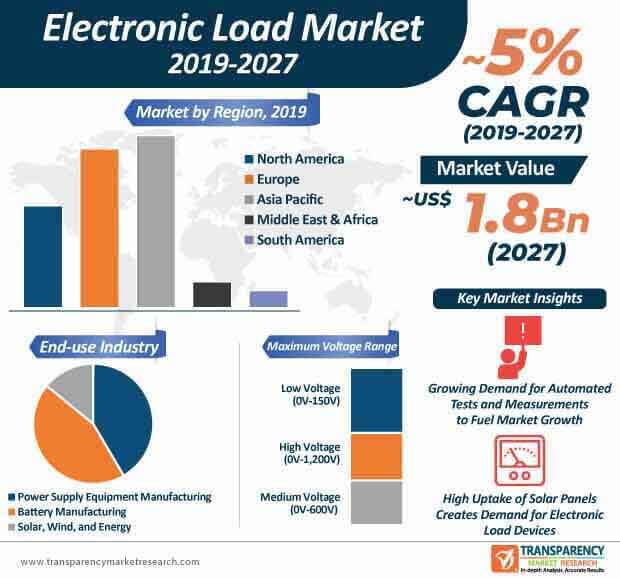
Use of Texas Instruments DSP Control Units in Electronic Load Devices Helps Boost Credibility of Emerging Players
Companies are utilizing conventional MOSFET-based dissipative elements that allow electronic load devices to achieve a wide voltage-current operating range within a device’s maximum power rating. This is evident, since high voltage (0V – 1,200V) is expected to be a prominent maximum voltage range segment of the electronic load market. Hence, companies are focusing on heat management in electronic load devices to deploy high density programmable DC power supplies. For instance, Magna Power- an electronics manufacturer in the U.S., is increasing its efforts to boost the uptake of ALx Series MagnaLOAD devices with conservative cooling to ensure longer product life compared to conventional devices.
The ever-growing energy industry including solar and wind energy, is creating a demand for electronic load devices to thoroughly test power sources of their products. Eco-friendly consumers are adopting home appliances that function on renewable energy such as solar panels and car batteries. Hence, companies in the market are developing programmable electronic loads that are increasingly replacing conventional resistors. Dynamic testing and rapid increasing and decreasing the load in repeatable fashion are some of the practices that stakeholders need to adopt in order to comply with quality and safety standards for their products.
You will get Custom Report at Syndicated Report price, Buy Now

Request a sample to get extensive insights into the Electronic Load Market
Technological Advancements Enable End Users to Virtually Assess Activities of Electronic Loads
Next-gen software interface is one of the key drivers contributing to the growth of the electronic load market. Companies are introducing software interface that provide intuitive and user-friendly web-browser-based control over the activities of electronic load devices. Programming and measurement through software is gradually becoming mainstream in the electronic load market. This trend has focused on the convenience of end users in the battery manufacturing industry that can virtually control and monitor the software. As such, battery manufacturing end-use industry is anticipated to lead the electronic load market. The electronic load market is estimated to reach a value of ~US$ 1.8 Bn by the end of 2027.
Get More Press Release by TMR: https://www.prnewswire.co.uk/news-releases/committed-demand-from-high-value-oil-and-gas-sector-that-drives-nearly-all-businesses-everyday-functioning-fuels-pup-joint-market-growth-predicted-at-healthy-7-cagr-for-2019-2027-tmr-800495387.html
Stakeholders Comply with Safety Standards Using Programmable DC Electronic Loads
Manufacturers in the electronic load market are developing devices that offer versatile functionality in various end-use industries. They are increasing efforts to develop automated test equipment for power discharge testing. These automated equipment are witnessing high demand in power supply and energy industries. As such, power supply equipment manufacturing end-use industry is projected to witness considerable growth in the electronic load market.





